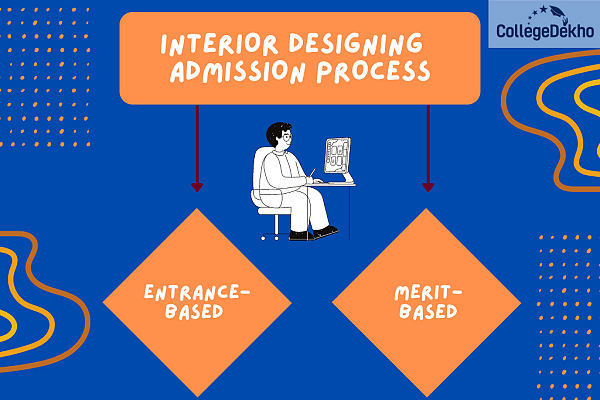Interior Designing
Interior Designing Course Overview
The interior designing course is a popular vocational programme offered by many private and government colleges in India. Students can choose from several specialisations such as BDes Interior Design, BA/BSc Interior Design, and Diploma in Interior Designing. Several universities and platforms are offering Interior Designing online courses. One can pursue a Diploma in Interior Designing, an undergraduate degree after completing their class 12 exam and Interior Design postgraduate programs after bachelors like MA/MSc Interior Design, MDes Interior Design, or Postgraduate Diploma in Interior Designing. There has been a high demand for interior designers in the market. The students learn several aspects of Interior Designing such as drawing, painting, conceptualisation, ideation, implementation and execution as per the demands of the clients.
Interior designing job opportunities after doing a Master's program is very good as students are placed in different design companies for multiple roles. NIFT, Pearl Academy, Mumbai University, IIFT, Amity University, etc. are some of the top Interior Design Colleges that offer full-time degree courses in Interior Design both at the undergraduate and postgraduate levels. The popular job roles after Interior Designing courses are Interior Designer, Interior design professor, Product Designer, Consultant and Researcher. The average salary offered to candidates is around INR 3-5 LPA.
Table of Contents
- Interior Designing Course Overview
- Interior Designing Course Highlights
- Why Choose an Interior Designing Degree?
- What is an Online Interior Designing Degree?
- What is the Difference Between an Interior Designing Course and a Graphic Designing Course?
- Types of Interior Designing Programs
- Interior Designing Course Eligibility Criteria
- Interior Designing Course Entrance Exams
- List of Popular Interior Designing Course Specialisations
- Interior Designing Course Admission Process in India
- Interior Designing Course Fees in India
- Interior Designing Course Syllabus/Subjects
- Top Private Interior Designing Colleges in India
- Top Government Interior Designing Colleges in India
- Career Options After Interior Designing Course
- Courses After Interior Designing
- Other Popular Courses
- FAQs about Interior Designing
Interior Designing Course Highlights
The following are some of the important highlights of the interior designing course:
| Particular | Detail |
|---|---|
| Name | Interior Designing Course |
| Duration | 2-4 years |
| Eligibility Criteria | Bachelor’s: Candidates must have cleared 10+2 with any specialisation with a minimum average score of 50%. Master’s: Applicants must have obtained a bachelor’s degree with at least 55-60% aggregate marks from a reputed board. |
| Admission Process | Merit + Entrance Exam |
| Top Entrance Exams | SEED, UCEED, AIEED, NID DAT, CEED, etc. |
| Course Fee | Bachelor’s: INR 20,000-12,00,000 Master’s: INR 2,00,000-10,00,000 |
| Top Colleges | Pearl Academy, IIAD, NID, INIFD Deccan, INSD Pune, CEPT University, and more. |
| Career Options | Teacher, Professor, Consultant, Interior Designer at Residence, Hotel Industry, Healthcare Industry, etc. |
| Average Salary | INR 3-10 LPA |
| Recruiting Companies | Gensler, HOK, Hersch Bedner Associates, Yabu Pushelberg, NID, Livespace, Shobha Developers, Vogue Institute of Art, Puran Interiors, Borito Designs, Kuvio Studio, Carafina |
Also Read: Best Design Colleges Apart from NID & NIFT
Why Choose an Interior Designing Degree?
In recent years, interest in interior design courses has increased. The popularity of interior designing courses in India has increased even though many celebrities, and others, have made the profession their choice of work. An interior designer is a professional who works closely with architects to enhance the aesthetic appeal of buildings. Enrolling in an interior design course is open to anyone with an artistic eye as highlighted in the infographic below.

The following are some of the most solid reasons to pursue a career in interior design:
- Nowadays, interior designing is a popular career path. It is becoming more and more popular, so there is a constant need for skilled professionals in the field.
- The interior designing courses are made to foster the growth of creative and critical thinking abilities.
- Candidates who pursue a career in interior designing can expect to be paid well.
- After completing an interior designing course, candidates have the option of working independently or with recruiters.
- Also, interior designing courses are available at both full-time and distance learning options. Hence, students are free to use any mode that suits their needs.
- Lastly, the interior design syllabus combines creativity and technology. The majority of colleges encourage both theoretical and practical methods for developing students' personalities and interpersonal skills.
What is an Online Interior Designing Degree?
With a huge demand and scope for interior design courses across the country, the number of institutions offering different types of interior designing courses is also increasing. Several online educational platforms have started offering certificate-level short-term interior designing courses. The students can check the list of popular courses along with their duration and fee structures.
| Course Name | Duration |
|---|---|
| How to Design a Room in 10 Easy Steps | 2 hours |
| Design is in the Details: How to Accessorize Like a Pro | 3 hours |
| How to Work with Interior Design Styles Like a Pro | 6 hours |
| The Complete Sketchup and Vray Course for Interior Design | 11 hours |
| How to Use Color Like a Pro | 2 hours |
What is the Difference Between an Interior Designing Course and a Graphic Designing Course?
As discussed, students enrolled in an interior designing course gain an in-depth comprehension of the many interior design styles as well as expertise in the numerous techniques and procedures used in this profession. On the other hand, graduates of the graphic designing course use their skills to generate visual content that conveys ideas. Using page layout approaches and visual hierarchy, graphic designers tailor fonts and images to the individual demands of users to maximise user experience. The following table highlights the primary differences between an interior designing course and a graphic designing course:
| Particular | Interior Designing | Graphic Designing |
|---|---|---|
| Educational Requirements | Usually calls for a degree in interior design or a comparable discipline. | Usually calls for formal graphic design training or a degree. |
| Emphasis | Places a focus on colour schemes, ambience, furniture placement, and creative use of space. | Strong focus on branding, typography, layout, and visual aesthetics. |
| Industry Opportunities | Possibilities in retail, real estate, hospitality, and commercial and residential design. | Possibilities in branding, site design, marketing, multimedia development, and advertising. |
| Job Flexibility | Possibilities for employment with design businesses or architecture firms as well as independent work. | Opportunities to work freelance are many and offer scheduling freedom. |
| Primary Tools | 3D modelling programs such as SketchUp and AutoCAD. | Photoshop, Illustrator, and other Adobe Creative Suite programs. |
| Work Type | Focuses on interior design, including material, colour, and furniture selection. | Involves producing visual material for web, print, and multimedia among other mediums. |
Types of Interior Designing Programs
A strong sense of space, technical proficiency, and artistic ability are all necessary in the creative profession of interior design. The growing appreciation for elegant environments among people drives the demand for interior designing course graduates. A variety of these programmes, ranging from certificates to master's degrees, are available to aspirants who want to develop their professional skills or broaden their understanding of design and space optimisation. Universities and other educational institutions provide a variety of online, full-time, and part-time courses for these as discussed below.
- Full-Time Interior Designing Course: Leading design schools in India provide several full-time bachelor's and master's degrees in interior design. These classes offer an in-depth comprehension of organising space, illumination, colour hypothesis, materials and finishes, and other basic concepts of interior design.
- Part-Time Interior Designing Course: For working people who are unable to dedicate the entire day to their education, part-time courses are a feasible choice. The only apparent variation in course material is the longer duration of these types of classes.
- Online Interior Designing Course: Due to its inexpensiveness tuition fee and ease of use, an online interior design course is growing in popularity. Candidates may expect video lectures, homework, answers to typical questions, and one-on-one support in these programmes. They offer instruction in 3D visualisation, design tools, and industry trends knowledge.
Also Read: Interior Designing Courses after 12th
Interior Designing Course Eligibility Criteria
The interior designing course-wise eligibility criteria have been tabulated below:
| Course Name | Eligibility Criteria |
|---|---|
| Diploma in Interior Design | Candidates must have completed their 10th or 10+2 with at least 50% marks in any subject. |
| PG Diploma in Interior Design | Candidates must have a graduate degree in any discipline with at least 55% marks from a recognised university. |
| Bachelor in Interior Design (BA, BSc, BDes or BArch) | Candidates must have completed 10+2 with at least 50% marks in any subject. |
| Master in Interior Design (MA, MSc, or MBA) | The candidate must be a graduate of any discipline with at least 55% marks from a recognised university. |
Skill Set Required to be an Interior Designer
Aspirants who want to become interior designers must be imaginative, have a sense of design, and be able to visualise. The following are the aptitude and fundamental abilities needed to become a successful interior designer:
| Ability to deal with technical details | Ability to work in a team |
|---|---|
| Scientific aptitude | Drawing aptitude |
| Analytical mind | Visual sensitivity |
| Colour sense | Ability to work on a given budget |
| Good communication skills | Knowledge of textures, materials and trends |
Interior Designing Course Entrance Exams
Many Interior Design colleges conduct entrance examinations to offer admission to various interior design courses. Besides that, there are entrance exams conducted at the national level which then provide admission to the best interior designing colleges in India. Below is a list of some of the important entrance exams related to interior design course admissions.
| Exam Name | Description |
|---|---|
| UCEED Exam | Undergraduate Common Entrance Examination for Design (UCEED) is a design entrance exam which is conducted by IIT Bombay every year to offer admission to Interior Design courses such as BDes. Candidates who successfully clear the entrance exam are then offered admission to different IITs. |
| SEED Exam | Symbiosis Institute of Design (SID) is an entrance exam conducted to offer admission to eligible candidates in the field of architecture and design. This examination is conducted jointly by IITs and the Indian Institute of Science across the country. |
| NID DAT | The Design Aptitude Test (NID DAT) is a national-level design entrance exam conducted by the National Institute of Design (NID). It is conducted every year to offer admission to eligible candidates in the field of interior design courses. |
| CEED Exam | Common Entrance Examination for Design is a joint entrance exam for post-graduate studies in Interior Design courses. It is held annually jointly at all IITs and the Indian Institute of Science across the country. |
| AIEED Exam | All India Entrance Examination for Design (AIEED) is conducted by the ARCH Academy of Design for admissions to undergraduate and postgraduate programmes. |
| UID DAT | Unitedworld Institute of Design (UID) administers the UID Design Aptitude Test for admission to design courses at UID Ahmedabad and UID NCR campuses. The UID Ahmedabad Campus offers BDes (Hons), MDes, and PhD programs, while the UID NCR Campus only offers a BDes (Hons) program. Candidates must first take the UID DAT. (Design Aptitude Test). Shortlisted candidates will then undergo a Situation Test and Portfolio Evaluation round. |
List of Popular Interior Designing Course Specialisations
Within the vast domain of interior design, an interior designer may specialise in various fields. These specialised industries and markets enable interior designers to do far more than most people would think possible. While some designers choose to focus on a specific area of expertise, others could choose to focus on a select few closely related subjects. There are various common specialisations available in the interior design field that one would wish to think about pursuing. The same is listed in the sequence that follows:
Interior Designing Course Specialisation #1: Commercial Interior Design
Commercial zones include places like workplaces, educational institutions, restaurants, retail stores, movie theatres, hotels, casinos, fitness centres, and salons. The goal of business interior design is to create a space that is both visually beautiful and useful for the end user.
Interior Designing Course Specialisation #2: Exhibit Design
Exhibit designers work with several departments within a company, such as marketing, development, research and development, manufacturing, operations, and legal, to decide what facts should be communicated through an exhibit.
Interior Designing Course Specialisation #3: Healthcare Interior Design
Healthcare interior designers are responsible for creating designs for clinics, physician offices, hospitals, diagnostic labs, and imaging facilities. Healthcare interior design, like other design fields, requires a methodical approach to designing rooms that benefit patients and improve the working environment for healthcare personnel.
Interior Designing Course Specialisation #4: Higher Education / Institutional Interiors
Higher education interior designers ensure that their rooms are practical for guests, employees, teachers, and students by collaborating with architects and other designers. They focus on designing study and social spaces as well as facilities where students live and learn, such as residence halls and social spaces.
Interior Designing Course Specialisation #5: Hospitality Interior Design
Hospitality interior designers work collaboratively with hotel owners, management, and marketing departments to create a design that offers guests a functional space while also complementing the property's style. Establishing environments that elicit a sense of ease and welcome is the goal of hospitality interior designers.
Interior Designing Course Specialisation #6: Lighting Design
Lighting designers are responsible for designing and implementing both outdoor and interior lighting. Lighting designers usually use computer simulations to forecast how light will be diffused around a space to highlight specific design elements and ensure that a room has enough light for daily tasks.
Interior Designing Course Specialisation #7: Residential Interior Design
Under the broad category of residential interior design, one can design a house, an apartment, a multi-family complex, or even a temporary place to live. To enhance the quality of life, any home should be a reflection of the owner's style and offer a cosy, practical environment to support their everyday needs.
Interior Designing Course Specialisation #8: Retail & Store Planning
It is the responsibility of retail shop designers to develop surroundings that are both aesthetically pleasing and functional enough to encourage customers to stay in the store longer, all the while providing adequate room for product displays and transaction processing. Store planners work in tandem with marketing teams, who provide geographic data including foot traffic and traffic trends, as well as insights into the kind of customers that will be visiting their retail outlets.
Interior Designing Course Specialisation #9: Sustainable Design
A sustainable designer may be responsible for creating or improving building systems such as lighting, plumbing, electrical, heating and cooling, and fire safety. To optimise the longevity and efficiency of their architectural designs, numerous designers and architects focus on integrating sustainable elements into their creations.
Interior Designing Course Admission Process in India
The interior designing admission procedure is majorly entrance-based. Some colleges, however, grant admission based on the merit list for this course. To get admission to any Interior Design college, students must meet the respective eligibility requirements and types outlined in the infographic below.

Interior Designing Entrance-Based Admissions
Candidates can apply for Interior Designing admission by following the steps outlined below:
Step 1: Check into the application form requirements and deadlines listed by various colleges and universities if you want admission to an Interior Designing course programme.
Step 2: Register for the entrance exams required for Interior Designing course admissions at the colleges and universities you want to attend.
Step 3: Once confirmed, save the application process for future use. Also, for admission and other important notifications, keep an eye on the release of exam notifications.
Step 4: After appearing and passing the interior designing entrance examination, candidates are shortlisted for the next round which is the portfolio and interview round.
Step 5: Candidates who successfully clear all the rounds get shortlisted for the final phase which is a counselling round (if any) to finalise the admissions process.
Step 6: After clearing the counselling session, candidates must pay the university's entrance fee to confirm their admission to the Interior Designing course.
Interior Designing Merit-Based Admissions
Candidates can apply for Interior Designing by following the steps outlined below:
Step 1: Fill out the online Interior Designing application form.
Step 2: Pay the registration fee and any additional fees if admission is granted based on merit.
Step 3: The shortlisted applicants will receive invitations to the subsequent phases of the hiring process, such as individual interviews or counselling.
Step 4: Candidates must submit all the required documents and fees to confirm their admission to the Interior Designing course.
Interior Designing Course Fees in India
Interior Designing course fees vary depending on the course type. Undergraduate interior design courses have different Interior Design fees. Interior Design fees for diploma and certificate courses differ as well. The fees are also determined by the type of interior design college or university where the candidate is pursuing his or her interior designing course.
| Interior Designing Colleges | Interior Designing Fees (in INR) |
|---|---|
| Indian Institute of Art & Design (IIAD) | 4,80,000-5,60,000 |
| New Delhi YMCA | 65,000-1,34,000 |
| Artemisia College of Art and Design | 50,000-1,20,000 |
| Amity University, Noida | 1,20,000-2,40,000 |
| JD Institute of Fashion Technology | 2,10,000-2,50,000 |
Interior Designing Course Syllabus/Subjects
Interior Design course deals with creativity and innovation. The interior design syllabus is designed in such a way that it will help the students enhance their designing skills while also learning about various tactics and techniques. The following is a discussion of the interior designing subjects and syllabus.
- Theory of Design
- Freehand Drawing & Geometric Construction
- Research Strategies Design Process
- Analytical Drawing
- Humanities, Art Appreciation and Appraisal
- Anthropometry and Ergonomics
- Technical drawings and Computer Applications
- Cost Estimation
- Arts and Crafts
- Professional Practice
- Specifications and Controls
Top Private Interior Designing Colleges in India
Candidates can pursue Interior Design courses at the undergraduate or postgraduate level, as well as certificate courses. Here is the list of top private interior design colleges tabulated below:
| College Name | Total Course Fee (in INR) |
|---|---|
| Vogue Institute of Art and Design Bangalore | 1-7 LPA |
| Symbiosis Institute of Design Pune | 17 LPA |
| Silver Oak University | 4-10 LPA |
| Pearl Academy Jaipur | 7-18 LPA |
| Pearl Academy Delhi | 2-20 LPA |
| Lovely Professional University Jalandhar | 5-10 LPA |
| JD Institute of Fashion Technology | 4-8 LPA |
| IIAD Delhi | 21.1 LPA |
| Chandigarh University | 5-7 LPA |
| Army Institute of Fashion and Design Bangalore | 6 LPA |
| Amity University Noida | 3-8 LPA |
Source: Official websites of the respective colleges.
Top Government Interior Designing Colleges in India
Here is the list of top government interior designing colleges tabulated below:
| College Name | Total Course Fees (in INR) |
|---|---|
| Yashwantrao Chavan Maharashtra Open University, Nashik | 13,000 to 40,000 |
| SNDT College, Mumbai | 53,000 to 2,00,000 |
| NIFT Delhi | 2,00,000 |
| NID Ahmedabad | 11,00,000 to 15,00,000 |
| JNAFAU, Hyderabad | 2,00,000 to 3,00,000 |
| Guru Gobind Singh Indraprastha University, Delhi | 2,00,000 to 3,00,000 |
| Gujarat University, Ahmedabad | 7,00,000 |
| DAVV, Indore | 10,000 to 63,000 |
| CSJM, Kanpur | 30,000 to 91,000 |
| Annamalai University | 1,00,000 |
Career Options After Interior Designing Course
As more and more cutting-edge buildings are built, interior designers are in high demand because these buildings need to have the right interior design to be aesthetically pleasing. Any construction project needs interior designers because they decide where to put all the amenities inside the room.
Over the years, as artistic minds have expanded, improvements in people's living standards and expectations have increased. Interior design is important because it can highlight various symbolic events and meanings. For graduates in interior design, many architecture firms have opened up various opportunities. The following is a discussion about the career options after the interior designing course such as job profiles, average salary, top recruiters, etc.
Top Job Profiles for Interior Designing Course Graduates
The selection of accent pieces, furniture, draperies, and wall colours is the responsibility of an interior designer. The majority of interior designers start in small architectural firms. However, over time, the majority of these experts start their businesses. Depending on their experience and the company they work for, interior designers receive different salaries. Listed below are some popular interior designing jobs for graduates.
- Consultant
- Design Journalist
- Interior Design
- Product Designer
- Researcher
- Teacher
Also Read: Design Career in India
Top Recruiters for Interior Designing Course Graduates
The following is a list of some of the top recruiters for interior designers:
| Gauri Khan Designs | Urban Ladder |
|---|---|
| DesignQube | The Karighars |
| De Panache | Savio and Rupa Interior Concepts |
| Morph Design Co | Pinakin Design |
| Carafina | La Sorogeeka |
Salary for Interior Designing Course Graduates
According to a Glassdoor survey, the average annual salary for interior designers in India is INR 3 LPA. Based on factors like experience, job profile, and more, we have divided the salaries paid to interior designers into different categories below. Graduates in interior design, however, can anticipate annual salaries of between INR 93,000-6,00,000. After gaining about 10 years of experience, people in this profession can expect to make about INR 12 LPA. The following table shows the average annual interior designing salary based on their job profile:
| Job Profile | Average Annual Salary (in INR) |
|---|---|
| Interior Designer | 3 LPA |
| Industrial Designer | 6 LPA |
| Design Manager | 3.6 LPA |
| Interior Decorator | 4 LPA |
| Home Designer | 3 LPA |
| Design Journalist | 4 LPA |
| Bedroom Designer | 3 LPA |
Courses After Interior Designing
As discussed, interior designers provide businesses and homeowners with assistance in organising the design, construction, colour palettes, furniture, and décor of their homes. The primary responsibility of an interior decorator or designer is to provide both practical and aesthetically pleasing elements for any given space.
Postgraduate, undergraduate, diploma, and certification programmes are available in the different types of interior designing courses offered. At the undergraduate level, candidates can pursue a BA, BDes, BSc, or diploma in interior design. Students can pursue postgraduate degrees such as Master of Arts (MA), Master of Design (MDes), or Master of Science in Interior Design after earning a bachelor's degree. They can increase their knowledge and proficiency by enrolling in postgraduate diploma courses. Becoming an interior designer or interior decorator is the most typical and well-liked professional path following a degree in the interior designing course.
Other Popular Courses
FAQs about Interior Designing
What are the main subjects of the Interior Designing course?
The main subjects of the Interior Design course are Auto CAD, Basic Design Principles, Communication skills, Design Process, English Language Usage Essentials, Environmental Studies, Flat rendering and layouts, Fundamentals of Design, History of Interior Design, Interior Design Environments, Introduction to Computers, Materials and Construction Techniques, Model Making Workshop, Presentation and Communication skills, Principles of Interior Design, Research Strategies & Design Process, Residential Interior Design, Space Layout and Design, etc.
What are the top employment areas for Interior Designing course graduates?
The top employment areas for Interior Designing course graduates are Leisure avenues, the Education Sector, Retail Stores, the Hospitality Sector, the Healthcare Sector, etc. Numerous studies of the industry indicate that interior design is becoming more popular. For example, P&S Intelligence forecasts that the market for interior design will expand by 14.1% between 2020 and 2030. There are several workplaces where an interior designer might get employment such as Shopping malls, Restaurants, Gyms, Warehouses, etc.
Can I pursue Interior Designing courses after 10th grade?
Yes, prospective students can pursue Interior Designing courses after 10th grade at a certificate or diploma level depending on whether a respective institution allows admissions or not. However, if you wish to work in interior design, it is not recommended that you take these courses. You cannot obtain an in-depth comprehension of interior design as a field and its applications via a diploma or certificate programme. For people who choose to study interior design for knowledge or as a hobby, certificate and diploma degrees are a good possibility.
What are the various types of Interior Designing courses?
The various types of Interior Designing courses can be pursued at diploma, UG, PG, and doctorate levels. It includes programmes such as PG Diploma in Interior Designing, MSc Interior Design, MBA Interior Design, MA Interior Design, Diploma in Interior Design, BSc Interior Design, BDes Interior Design, BArch Interior Design, Bachelor of Interior Design (BID), and more.
Who can pursue an Interior Designing course?
An Interior Designing course can be pursued by individuals who are innovative and have a strong sense of vision. In addition to having the capacity to manage the client's budget and the business itself, they should be proficient in making plans. This programme is for students who want to demonstrate their capacity to innovate and adjust to changing conditions by employing the execution of interior design.
What does an Interior Designing course graduate do?
An Interior Designing course graduate does takes numerous responsibilities such as providing businesses and homeowners with assistance in organising the design, construction, colour palettes, furniture, and decor of their buildings. An interior designer or decorator's primary responsibility is to provide practical products and an appealing appearance for any given space. Becoming an interior designer or interior decorator is the most typical and well-liked professional path following an interior designing degree.
What is the minimum age to apply for Interior Design?
No, there is no predetermined age limit for enrollment in some Interior Design courses, primarily diploma-level courses. However, for B.Des and M.Des courses the institutions set their age criteria for students as they are conducted in regular mode. It is important to check out the requirements before signing up for the courses.
Which field must I choose if I want to take up Interior Designing?
There is no particular field requirement for Interior Designing courses. Any person from any stream may choose to enroll in this course. There should be a sense of design and aesthetic sensibility that give an added advantage to individuals pursuing this course.
Is becoming an interior designer my only option if I study an interior designing course?
No, becoming an interior designer is not your only option if you study an interior designing course, you have many more choices. You could work as a consultant, product designer, researcher or teacher. There are numerous options for you to explore with your interior design knowledge.
What is the average course fee for BDes in Interior Designing?
The average course fee for BDes in Interior Designing is between INR 10,000 to 1,00,000 per year or it may be as high as INR 20 as the total course fee, depending upon the type of programme a student has opted for. Certificate and diploma programmes have relatively low tuition fees ranging from INR 5,000 to 3,00,000. Government colleges charge between INR 2-6 LPA for the whole course of a four-year degree, while the majority of private colleges charge more in the range of INR 8 to 20 lakhs.
What are the top recruiters for interior designing course graduates?
The list of top recruiters for interior designing course graduates includes Design Cafe, Design in India, Home Lane, Hub, Maps of India, Morpheus Human Consulting, Synergy Corporate Interiors, The Grid, The Karigars, Urban Clap, and more. When they first start their professions, the majority of interior designers work for large architecture firms. The college or university where the designer completed the degree, their academic background, and their skill sets are just a few of the many variables that may affect their salary.
What subjects should I study for interior designing entrance exams?
The subjects you should study for interior designing entrance exams vary from one college to another as they may have a different set of topics and subject requirements. However, these cover topics such as design theory, drawing fundamentals, colour terminology, lateral thinking, visual logic, memory drawing, design awareness, and other related ones.
Is Math required for admission to interior designing courses?
No, Math is not required for admission to interior designing courses. For the successful operation of an interior design business as well as the day-to-day duties of an interior designer, however, basic math skills are necessary. Calculating the size of a room and the amount of fabric needed for drapes and upholstery are skills that interior designers must possess.
What is the duration of the interior designing course?
The duration of an interior designing course depends upon the type of degree in which you enrol. For example, a BDes in Interior Design takes four years to complete, while a BSc in Interior Design takes three years to complete. A postgraduate degree in the specialisation is two years long while certificate and diploma programmes are between 3 and 24 months.
Does any IIT offer interior designing courses?
Yes, IIT Bombay offers interior designing courses, which is well-known for its engineering programmes, and provides training as well. The industrial design centre is one of 15 departments at IIT Bombay. This department provides instruction and space for students to conduct design-related research.
What exactly is the Interior Design programme?
Online interior design courses are the ideal combination of art and science. An interior design graduate creates artistic work by applying scientific theories and concepts. They use their imagination to improve the interiors of buildings and come up with unique and creative plans and ideas.
How should I prepare for the entrance exam for Interior Design course?
There are two major aspects to consider before taking the exam: the examination and the interview. The examinations will assess the student's fundamental skills and knowledge. The interview will include questions designed to gauge the student's interest in the field.
What is the scope of interior design?
After completing a UG-level course in Interior Design, one can either continue their education or get a job. The following are some PG-level courses that students should consider taking:
- MDes Interior Design
- MDes Furniture and Interior Design
- MSc Interior Design
- MVoc Interior Designing and Business Management
- MBA Interior Designing
- PG Programme Interior Design and Styling
- Master Diploma Interior Designing
- Advanced Diploma in Interior Design
- Professional Certificate Styling for Interior
What skills are required to become an interior designer?
The following skills are required to become an interior designer:
- Trend identification
- Superior communication
- Organisation
- A creative eye and attention to detail
- Knowledge of sustainable practices
- Sketching ability and computer knowledge
What is the salary offered to interior design course graduates in India?
The salary offered to interior design course graduates in India depends upon the level of degree they have obtained as well as their job profiles. For example, the beginner-level salary of a candidate with an undergraduate degree in interior design is approximately INR 2.5-4 LPA.
What are the career prospects after pursuing an interior designing course?
The career prospects after pursuing an interior designing course are numerous in various sectors. Depending upon the level of your qualification, the job roles and salary may vary. With a degree in this field, you may become an interior designer, a design consultant, an exhibition designer, a home stylist, a theatre designer, etc.
Which are the best colleges for interior designing courses in India?
The list of the best colleges for interior designing courses in India that offer various programmes at different levels includes the National Institutes of Fashion Technology (NIFTs), the National Institutes of Design (NIDs), the Indian Institute of Art & Design (IIAD Delhi), Pearl Academy, IDC - IIT Bombay, etc.
Do I have to appear for an entrance exam for admission to an interior design course?
Whether a student has to appear for an entrance exam for admission to an interior design course depends on their preferred institution as it varies from one college to another. Some institutes give admission based on a candidate's merit while for some, candidates have to appear for a national/ state/institute-level entrance exam. Some popular design entrance exams include UCEED, CEED, NID DAT, NIFT Entrance Exam, AIEED, NATA, etc.
What is the minimum qualification required for an interior designing course?
The minimum qualification required for an interior designing course depends on the type and level of programme a student chooses to enrol in. For example, if you seek admission to a bachelor's degree in interior design, you should have completed class 12th or its equivalent from a recognised board of education. For admission to a master's degree in interior design, you must have a relevant bachelor's degree in a similar field.
Can I pursue interior designing courses after 12th grade?
Yes, you can pursue interior designing courses after 12th grade. For this, programmes such as Bachelor of Design (BDes) and Bachelor of Science (BSc) are the top choices of students in this field. Further, you can also opt for a certificate or diploma course in interior design.
Related Questions
Popular Courses
- Courses
- Interior Designing

















